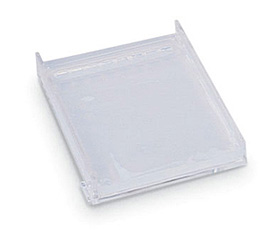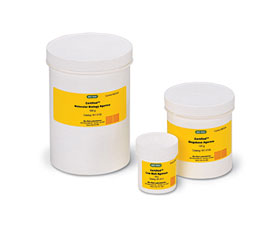Agarose Gel Electrophoresis for DNA, RNA, or Protein
Agarose gel electrophoresis is most commonly used to separate mixtures of DNA fragments of varying sizes, typically after restriction enzyme digestion or PCR. Agarose gel electrophoresis can also be used to separate RNA molecules if care is taken to avoid RNA degradation; in certain limited applications, peptides or proteins may also be purified by agarose gel electrophoresis. Nucleic acids are generally separated by length, although the presence or absence of secondary structures such as those observed in plasmids with varying degrees of DNA supercoiling also affects the rate of migration during agarose gel electrophoresis.
Although polyacrylamide gel electrophoresis (PAGE) can deliver a higher resolution than agarose gel electrophoresis (that is, PAGE can provide a cleaner separation of molecules of different sizes), agarose gel electrophoresis has several important advantages: a single gel can separate a much broader range of molecular sizes, nucleic acids are easy to visualize with fluorescent staining, and the extraction of DNA bands for subsequent purification and use is simpler and more efficient.
Using Precast Agarose Gels
There are many benefits to using precast agarose gels. The principal advantages of precast gels include both speed and the assurance of consistent run conditions across loadings and between experiments. This consistency is particularly useful when screening for small changes or comparing a large number of samples.
Bio-Rad precast agarose gels provide high-resolution separation of DNA fragments from 20–20,000 bp long. Precast agarose gels are available with TAE or TBE buffer, 1% or 3% agarose, with or without ethidium bromide, and in a range of well configurations, from 8 wells to 4 rows x 26 wells. Selected precast agarose gels are available with well spacing that is designed for high-throughput loading with a multichannel pipet. Bio-Rad precast agarose gels are available in sizes that fit many common horizontal gel electrophoresis systems, including all Bio-Rad horizontal gel electrophoresis systems.
ReadyAgarose™ precast agarose gels come in ready-to-load UV-transparent running trays with fluorescent well numbering, a handy feature for sample identification with a large number of samples or a complicated loading pattern. The trays also have a fluorescent ruler along one side for convenient measurement of band migration.
Another advantage of using Bio-Rad precast gels for agarose gel electrophoresis is that the running tray locks into place in Mini-Sub cell GT gel boxes. Using this system, agarose gels cannot shift during sample loading, putting the lid on the box, or the initial stages of electrophoresis. The locking tray system prevents the loss of samples from wells, and bands remain sharp because all the samples remain confined within the wells prior to electrophoresis down the gel.
Agarose Gels in the Classroom
Agarose gel electrophoresis is an excellent teaching tool for students in laboratory science classes from middle school through early college. A wide range of hands-on activities featuring agarose gel electrophoresis is amenable to typical class sizes and can be targeted to many different levels. Topics can range from studying molecular sieving in order to determine which dyes are used in candies, to cloning, or the analysis of PCR products.
Bio-Rad has a wide range of products for agarose gel electrophoresis as well as an expanding number of kits that provide both educational and fun experiences. A large library of support materials is available including manuals, curricula, and other resources to aid in teaching the theory and practice of molecular biology in a variety of applications. Educational discounts are available for qualified educators.
Agarose and Related Products
-
Electrophoresis Supplies
-
Electrophoresis Equipment and Systems
-
Nucleic Acid Blotting Products
Related Topics
cDNA Synthesis, High Capacity cDNA Reverse Transcription Kit, PCR Master Mix, Thermocycler, SYBR Green qPCR, SYBR Green Master Mix, SYBR Green


